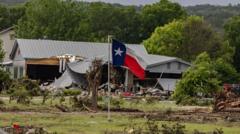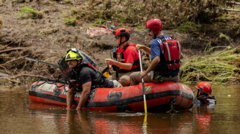In central Texas, flash flooding caused by severe rainfall has led to a heartbreaking death toll, with 79 confirmed dead, including 21 children. As rescue efforts continue, questions arise about the effectiveness of local emergency response due to staffing shortages at the National Weather Service. Experts link the intensity of such weather events to climate change.
Texas Floods Claim Lives and Spark Concerns Over Weather Preparedness

Texas Floods Claim Lives and Spark Concerns Over Weather Preparedness
A devastating flood in Texas has resulted in nearly 80 fatalities, including many children, prompting scrutiny of emergency response systems.
Severe flash flooding in Texas has wreaked havoc, with the death toll tragically rising to 79, including 21 children. The devastating situation unfolded when heavy rains inundated central Texas, particularly affecting the Guadalupe River—where the water levels dramatically surged by 22 feet over the span of just three hours. With rescue operations in full swing, search teams have been combing areas heavily impacted by the floods.
Among the deceased, authorities reported that 22 bodies remain unidentified, including four children. The grim search continues for eleven campers and one counselor from Camp Mystic, a summer camp for girls that hosted around 750 girls. Disturbingly, two campers aged 8 and 9 are among those who lost their lives in this tragedy.
The first alert regarding the impending flash floods was issued just before midnight Thursday. By 4 a.m. Friday, local authorities were urging residents and campers alike to seek higher ground immediately as the situation escalated. While the rainfall has created immense challenges, weather experts have noted concerning gaps in local emergency management—the National Weather Service reportedly had key positions unfilled, raising alarms over preparedness.
Additionally, climatologists have highlighted a worrying trend: extreme weather events, such as the Texas floods, are becoming increasingly frequent and severe due to climate change driven by fossil fuel emissions. As the community begins to rebuild and recover, it remains essential for local and federal agencies to reassess their emergency response strategies in light of this devastating event.




















